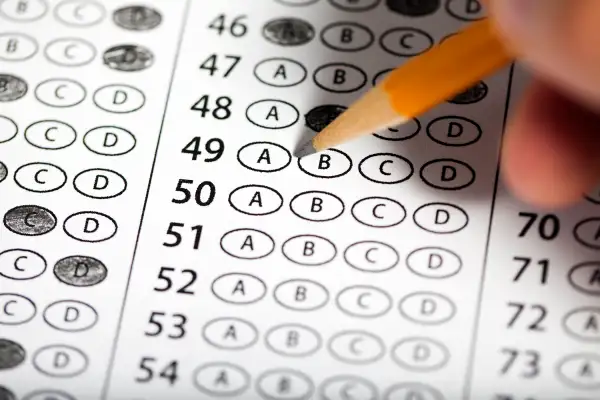5 Ways to Help Your Kid With the New SAT—Without Driving Both of You Crazy

For many parents and caregivers, helping their high schoolers prepare for standardized tests can be overwhelming. And for students taking the SAT this fall, the test will look a bit different than it did last year.
Most notably, the scoring has returned to a maximum overall score of 1600—meaning that a student’s score on the most recent SAT may have looked more like her parents’ or teachers’ scores than that of an older sibling (the SAT moved from a maximum score of 1600 to a maximum of 2400 in 2005 when the writing section was added).
On the current exam, students can score up to 800 points on each of the two sections: Reading/Writing and Math. Students can also score up to 8 points on each of the three (optional!) essay portions of the test. While the essays are not required, some colleges like to see the scores, so parents and students should consider whether taking the essay section makes sense.
Students will also get more granular score reports than in the past. Instead of the scoring structure of the old test (one score per subject area), the new SAT will provide students with subscores within each subject. This way, students can see where they excelled and the areas they’ll need to work on if they take the test a second time. For example, students may find that they are strong on Expression of Ideas within writing, but struggle with Standard English Conventions (i.e. grammar).
The biggest change, however, comes with the new content. The test has been rewritten to assess the skills and knowledge that, compared to the old test, are more aligned to what students are learning in high school, and what they’ll need to know in college. So instead of a focusing on vocabulary and reasoning, the new SAT measures students’ ability in areas that have been identified as important for college readiness, including interpreting reading passages, using reasoning to solve science questions, and math that is most used in career settings.
From a test–taking perspective, the student’s experience and strategy will change as well. While the old SAT penalized students for wrong answers, leading many students to leave questions blank rather than guess, the new test does not. This means that if students have an educated guess, they should go for it!
The test also changes the number of multiple choice options, from five answer choices on the old test to four on the new test. The timing and structure has also changed, from 10 total sections on the old test (taking 3 hours and 45 minutes) to four sections (plus the optional essay) on the new test. For those who take the new test without the essay, the exam will be dramatically shorter—only 3 hours total. Those who opt for the essay will add an additional 50 minutes to their testing time, making the overall time close to that of the old test.
Related: How to Get Into a Great College Without Great Test Scores
Students caught in the middle of the transition may experience some confusion and anxiety as the process works itself out. For parents, here are five ways to help alleviate any uncertainty before and after the test:
(1) Help them prepare with the right tools. The new version of the test measures different variables than the old test. Therefore, taking a test–prep class, using a test–prep book, or Googling SAT test prep may not prepare students in the best way. Be sure that they are using prep resources that are geared toward the new SAT test.
(2) Learn about the new format. Talk with counselors and college admissions professionals, and consult online resources so you are familiar with the new test format, its changes, and the scoring methods so you can put your student at ease throughout the process.
(3) Know how to interpret the scores. When you get the results, look closely at them to see where your student lands on each scale. You can convert test scores using one of many tools available on the Internet to see what the score would look like in the old format. Although you don’t have to convert the score, having this number available to you may help when looking at college admissions data that may not yet be updated.
(4) Open the lines of communication with schools. Encourage your student to communicate directly with the colleges he or she is interested in. Students can inquire about how their SAT scores, subscores, and essay scores measure up to the college’s admissions standards. And don’t forget, some colleges are test-optional, so in that case, your student may not even need to submit scores!
(5) Remain calm. It’s easy to get worked up in a time of change. When you are calm and understanding, your student will follow your lead. The college planning process should be fun. Lead by example!
Kim Oppelt is education and outreach manager for Hobsons, the company behind Naviance and other college-related services. She last wrote for us on "5 Smart Reasons to Consider a Gap Year Before College."